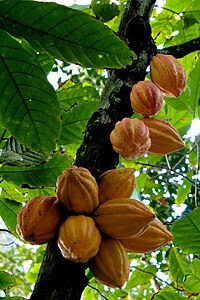
Photo from wikipedia
Cacao (Theobroma cacao L.) accessions conserved at the International Cocoa Genebank Trinidad (ICGT) are routinely characterised and evaluated in terms of traits of taxonomic and economic interest. The resulting data… Click to show full abstract
Cacao (Theobroma cacao L.) accessions conserved at the International Cocoa Genebank Trinidad (ICGT) are routinely characterised and evaluated in terms of traits of taxonomic and economic interest. The resulting data are crucial for selecting suitable candidates for future germplasm utilisation and breeding. In this study, the distribution of traits of taxonomic and economic interest was examined among Trinitario accession groups, represented by 260 accessions, and compared to what pertains for the 1900 genotypes characterised at the ICGT. Among the 1900 accessions studied, the Pod Index, an indicator of yield potential, ranged from 13.9 to 92.8. Twenty-three percent of the accessions with superior yield potential (Pod Index of 21 or lower) were ‘Trinitarios’, including the best. Despite a significantly negative correlation (r = − 0.162, P < 0.0001) between seed mass and seed number of the accessions studied, several Trinitarios combined large seed number (44 or more) with large seed (cotyledon) mass (1.2 g or more). The Trinitarios selected in Trinidad were observed to be phenotypically closely related. Trinitarios with high yield potential, large seed size and other favourable traits were identified. They are potentially useful sources of genes for introgression into Trinitario planting material in fine or flavour cocoa producing countries, which provide premium cocoa to an ever expanding global niche market. The resulting economic and social benefits of improvement in Trinitario cacao planting material should be significant.
Journal Title: Genetic Resources and Crop Evolution
Year Published: 2019
Link to full text (if available)
Share on Social Media: Sign Up to like & get
recommendations!